

Authors: Mike Smith & Marita Bradshaw, National Rock Garden Steering Committee
Extract from National Rock Garden Newsletter No. 18, October 2019
Introduction
The 2019 Canberra and Region Heritage Festival featured over 200 diverse events across the Canberra region, running from 13 April to 5 May. Now in its 37th year, the Festival raises awareness of the ongoing need to conserve our natural, historic and Aboriginal heritage. With the Festival theme being SPACE, the National Rock Garden Steering Committee decided to participate on three of the Festival days, with a display theme of ‘Space Rocks Reveal Earth’ to tell the stories of meteorites and tektites by showing rocks that represent the key components of the earth and their links to other parts of the solar system.

1st day—Gungahlin Homestead
Our display on the 1st day of the Canberra and Region Heritage Festival was located under cover on the veranda adjacent to main meeting area for this National Trust (ACT) organised festival event at the historic Gungahlin Homestead in Crace, ACT. This area featured other displays on the history of the ACT, craft activity, and antique handgun collection, choral singing, swing dancing, face painting and food/drink preparation and sale. The National Rock Garden presented the only display with a science focus. The banner (shown above and to right) was prominent above our table, and the sandwich board clearly identified our activity – many thanks to Geoscience Australia (GA) for assisting with these. Our stand was manned throughout the day by Marita Bradshaw, Ken McQueen and Mike Smith, and Brad Pillans assisted with setting up the display in the morning.
Marita populated the table with the following items:
- A globe showing the internal structure of the Earth (thanks GA)
- The olivine-in-basalt bomb showing the character of the mantle (again thanks to GA)
- An enclosed box (thanks Ken) containing iron meteorites, tektites & shatter cone
- Samples of vesicular basalt, and of dense columnar basalt
- A cut block of granodiorite from Young
- Numerous visual displays relevant to our display theme, such as columnar basalt on Mars and vesicular basalt from the Moon.
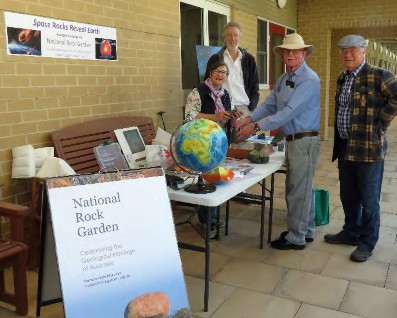
The booth was close to other interesting displays and was easy to visit by the attendees (estimated to be around 750) so the NRG team had a very busy day explaining the rocks, the Earth’s structure, as well as the progress and plans for the National Rock Garden development. There was some surprise when the effective use of a geological hand lens enabled children and lay people to see the coarse minerals of the granodiorite, and the bright green crystals of olivine.
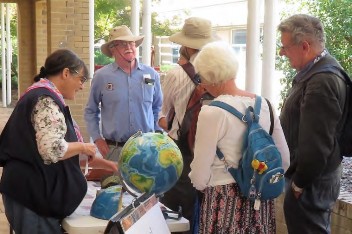
We found many people did have a limited awareness of the NRG, and they were all keen to hear more. There were others who had never heard of the NRG and of our goals, thus the display definitely communicated to Canberra citizens who might otherwise not have learned about the NRG. Our new brochure was taken by most visitors. We received one generous donation of $100 and we also added several new names and email addresses to the Friends of the NRG.
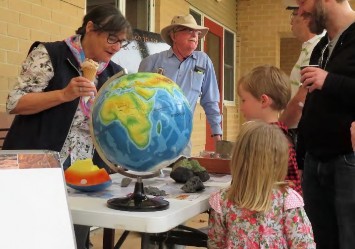
Children were quite prominent at the Festival Opening, and the science elements of the NRG display held the attention of younger visitors, some of whom already expressed a desire to be geologists. The globe with the removable sector showing the internal structure of the Earth was particularly useful in demonstrating the link between the thick mantle below the crust and the beautiful green olivine sample; and from the iron core to the meteorites on display. The geometric perfection of the heavy columnar basalt block and its contrast with the light and porous sample of vesicular basalt encouraged a lot of hands-on investigation.
The tour of the historic homestead was quite rewarding – the primary construction material (shown to right) is Black Mountain Sandstone, which was a key local material for many of the early big buildings of Canberra.
Ken McQueen is compiling a preliminary description of this rock, which is likely to prove to be a suitable inclusion for the NRG if there is a large block available at the quarry site.
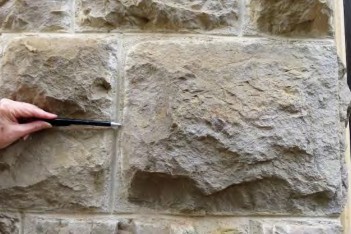
2nd day—National Dinosaur Museum
On Sunday 28 April, we set up our display on the sunny veranda of the National Dinosaur Museum. Brad, Matt and Marita manned the booth and our generous hosts at the Dinosaur Museum helped with set-up and packing away.
The location was most appropriate as the Dinosaur Museum contains an excellent display of geologic specimens, including two large iron meteorites. It was not as busy as at Gungahlin Homestead but we saw about 15 different groups of people, and all ages were interested in the Earth. Notices of our event by the Dinosaur Museum and Heritage Festival contributed to visits from interstate travellers in Canberra for a wedding; and some families with annual passes to the Dinosaur Museum, who made a special trip out to see our display. Again, we added several new names and email addresses to the Friends of the NRG.
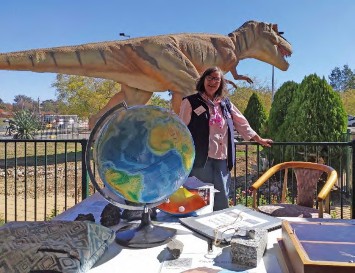
3rd day—Namadgi Visitor Centre
Our last outing was on Saturday 4 May down at Tharwa at the Namadgi Visitor Centre. Again, publicity about the display by the organisers of the Heritage Festival brought about 20 to 30 interested people along to our display of space-related material—the image at right shows some keen listeners. Marita Bradshaw, Michelle Cooper and Brad Pillans attended for the NRG, hosted by the ACT Parks and Conservation Service.
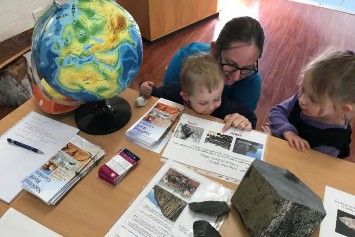
Namadgi is the Aboriginal name which refers to the mountains southwest of Canberra (a portion is shown in the image to right). Namadgi was declared a National Park in 1984 and covers an area of 106,095 hectares. In April 2001, the Ngunnawal people were given official recognition of their association with the land and cooperatively manage the park with the ACT Government. See: https://www.canberratracks.act.gov.au/heritage-trails/track-1-ngunnawal-country/namadgi-visitor-centre
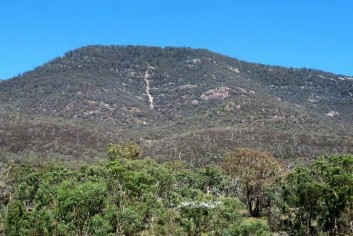
Conclusion
We recommend further involvement of the NRG in the Canberra Heritage Festival. The events are well promoted and well organised, and provide opportunities to raise awareness of the National Rock Garden with the broader community. Another benefit is the chance to build relationships with other institutions, such the National Trust ACT, the National Dinosaur Museum, ACT Parks and Conservation Service and the ACT Environment, Planning and Sustainable Development Directorate, as well as the local indigenous communities.


